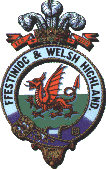











Ffestiniog Railway and Welsh Highland Railways
Harbour Station Porthmadog
Gwynedd Wales United Kingdom
N59.453123 W135.318266 (Porthmadog Station)
Ffestiniog and Welsh Highland Railway track now connects Caernarfon to Porthmadog to Blaenau Ffestiniog. The tramway track crossing the Britannia road bridge in Porthmadog from the Ffestiniog Railway's Harbour Station, and the final link between the two railways, is now complete and functional. From Caernarfon through Porthmadog to Blaenau Ffestiniog the two railways are 38 and a half miles in total length. In 2014 major track improvements opened at Porthmadog Station enabling cross-platform interchange between the two railways.
The roots of the WHR can be traced back to a horse drawn railway of 1828 evolving into a group of narrow gauge railways known as the North Wales Narrow Gauge Railways (NWNGR). The NWNGR was conceived by Charles E. Spooner, the secretary and engineer of the Ffestiniog until 1887. In 1877 he completed a line from Caernarfon to within 5 miles of Dinas . By 1881 tracks had reached Rhyd Ddu with the intent of serving slate quarries but passengers were encouraged to ride and view the scenery.
. By 1881 tracks had reached Rhyd Ddu with the intent of serving slate quarries but passengers were encouraged to ride and view the scenery.
By 1901 a railway named the Porthmadog Beddgelert & South Snowdon Railway (PBSSR) was formed to continue construction southwards towards Porthmadog but failed to complete the work. In 1906 construction did take place between Rhyd Ddu and Beddgelert and a start was made through the Aberglaslyn Pass.
and a start was made through the Aberglaslyn Pass.
The PBSSR ordered the steam locomotive Russell from the Hunslet company which is now the only surviving WHR locomotive in existence. The Aberglaslyn Pass
from the Hunslet company which is now the only surviving WHR locomotive in existence. The Aberglaslyn Pass tunnels were completed just as money ran out and they were abandoned. It wasn't until 1923 that another company named the Aluminium Corporation acquired control of the PBSSR and the NWNGR creating the Welsh Highland Railway and continued the line south into Porthmadog on the Crosstown Link
tunnels were completed just as money ran out and they were abandoned. It wasn't until 1923 that another company named the Aluminium Corporation acquired control of the PBSSR and the NWNGR creating the Welsh Highland Railway and continued the line south into Porthmadog on the Crosstown Link travelling over the Britannia Bridge
travelling over the Britannia Bridge .
.
The WHR's first year was a good traffic year, but then business began to fall off. With the slate industry in decline, trucks, busses, and vehicles coming into use, the WHR was forced into receivership by 1927. Somehow there was enough revenue to barely keep it going until 1937, then came closure. Equipment was requisitioned for the Second World War, Aberglaslyn Pass tracks came up in 1941, and the rest was mostly gone by 1948. The route between Caernarfon and Dinas was taken over by a standard gauge line, the London & North Western Railway, which was subsequently closed by British Rail in 1964.
In 1964 railway enthusiasts formed the Welsh Highland Light Railway (1964) Company Limited (now known as the Welsh Highland Heritage Railway) and laid track on an old standard gauge railbed between Porthmadog and Pen y Mount commencing public service in 1980. With the Ffestiniog Railway's completion of their deviation to Blaenau Ffestiniog in 1982 it started to eye the old WHR through Aberglaslyn Pass. By 1989 it had made a secret bid to the receiver of the WHR to acquire the route. They wished to construct south once again from Caernarfon to Porthmadog connecting with their line terminating at Harbour Station to thereby create 38 1/2 miles of 1 foot-11 1/2 inch narrow gauge trackage. In 1993 legal fighting broke out in Ffestiniog's attempt to gain control of the route. This resulted in three public inquiries and a High Court hearing. Finally a decision was made stating the reconstruction of the WHR by the Ffestiniog was in the public interest followed by approval for construction.
Volunteers started work, and by late 1997 service between Caernarfon and Dinas was in operation with five new carriages, Pullman car Bodysgallen , and two semi-open carriages.
, and two semi-open carriages.
The WHR acquired five South African NGG16 2-6-2+2-6-2 Garratts, numbers 130, 138 and 143 , plus number 140, donated to the WHR in 1997, which is used for spare parts. Cockerill built number 87
, plus number 140, donated to the WHR in 1997, which is used for spare parts. Cockerill built number 87 is also on the property. Two NG15 2-8-2 Mikados and a Funkey diesel named "Castell Caernarfon" were also acquired from South Africa.
is also on the property. Two NG15 2-8-2 Mikados and a Funkey diesel named "Castell Caernarfon" were also acquired from South Africa.
Volunteer labour next completed the tracks to Waunfawr and service commenced in August 2000. Rhyd Ddu was reached three years later on 18 Aug 2003.
Meanwhile, back in Porthmadog, the Welsh Highland Light Railway (1964) Company Limited, re-named Welsh Highland Railway Ltd., (now known as the Welsh Highland Heritage Railway) came to an agreement with the Ffestiniog to build north to Pont Croesor and operate their trains on that section until required by the Ffestiniog. They built only as far as Traeth Mawr loop, about halfway to Pont Croesor, and were operating on this portion by 2008.
In 2004 the Ffestiniog had funding in place to continue construction south from Rhyd Ddu, through Beddgelert, Aberglaslyn Pass, and into Porthmadog crossing the Britannia Bridge to reach Harbour Station with the Cross Town Link . Work started during the summer of 2005 and soon a switch
. Work started during the summer of 2005 and soon a switch which would connect the Welsh Highland Railway to the Ffestiniog was laid next to Spooners restaurant at Harbour Station. The Gold Spike, er... Golden Bolts
which would connect the Welsh Highland Railway to the Ffestiniog was laid next to Spooners restaurant at Harbour Station. The Gold Spike, er... Golden Bolts in this case, were installed at Harbour Station in Porthmadog on 28 Feb 2009. Shortly after locomotive K1 was photographed as one of many engines which would cross Britannia Bridge on the tramway
in this case, were installed at Harbour Station in Porthmadog on 28 Feb 2009. Shortly after locomotive K1 was photographed as one of many engines which would cross Britannia Bridge on the tramway .
.
The ruling grade is 1 in 40 or 2.5 percent. Click on the Grade Chart to enlarge it.